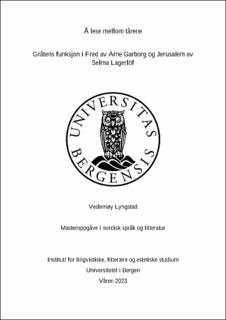| dc.contributor.author | Lyngstad, Veslemøy | |
| dc.date.accessioned | 2023-06-13T23:57:11Z | |
| dc.date.available | 2023-06-13T23:57:11Z | |
| dc.date.issued | 2023-05-15 | |
| dc.date.submitted | 2023-06-13T22:00:19Z | |
| dc.identifier.uri | https://hdl.handle.net/11250/3071227 | |
| dc.description.abstract | I denne masteroppgåva blir gråtens funksjon i Fred av Arne Garborg og Jerusalem av Selma Lagerlöf analysert og samanlikna. Romanane er skrive i tida rundt 1900 og begge skildrar bønder under andre halvdel av 1800-talet: den norske bonden hos Garborg og den svenske bonden hos Lagerlöf. Dei begge tematiserer bøndenes søken etter den eine og sanne kristne tru der det nasjonale og det religiøse blir problematisert i ei tid der bonden blei heva fram som eit nasjonalt ideal. For å svare på kva funksjon tårene spelar i romanane stiller eg spørsmåla: Er skildringar av tårer avhengig av den som græt? Kva slags funksjon får dei sakrale tårene, dei tårene som blir felt i nærleik til Gud? Kvifor kan bonden, som eit potensielt nasjonalt ideal, gråte når det nye mannsidealet på 1800-talet rekna tårer som ei feminin svakheit? Det teoretiske grunnlaget for å svare på spørsmåla er Peter Brooks og Stanley Cavells forsking på melodrama, Europeisk emosjonshistorie, Judith Butlers forståing av kjønn som performativitet og Raewyn Connells maskulinitetshierarki. Vi ser at romanane har eit tydeleg skilje i måtane dei skildrar kvinnelege og mannlege tårer. Den kvinnelege gråten blir i begge romanar ofte inngåande skildra som plutselege utbrot med store mengder tårer der forfattarane framstiller dei med låg grad av emosjonskontroll. Dei kvinnelege tårene liknar også på skildringar av barnetårer, noko som tydeleggjer tårer som eit infantilt og kvinneleg trekk. Likevel skil Karin Ingmarsdotter i Jerusalem seg frå dei typiske kvinnelege tårene ved å ha ein hyppigare frekvens av semitårer. Tårene bidrar til å definere maskulinitet i tidas bondesamfunn. I Jerusalem er Ingmar skildra som ein fåmælt bonde som i høg grad kan kontrollere kjenslene sine. Likevel græt han i svært få augeblikk fordi han som symbol på nasjonens sunne kjerne, og som berar av ein hegemonisk maskulinitet, også må vise sine indre emosjonar på ein kroppsleg måte for å vere menneskeleg. I Fred græt berre bonden Enok i religiøse kontekstar. Han kan plasserast innanfor ein deltakande maskulinitet, men maskuliniteten blir redusert til ein underordna maskulinitet når tårene utviklar seg til sjukdomsteikn. Jerusalem problematisera, men også foreinar det nasjonale og det religiøse ved å la kollektivet gråte. Fred problematisera mest av alt det religiøse, der Enok ikkje kan bli eit nasjonalt bondeideal fordi han ikkje deler religiøsiteten sin med nokon og tårene går inn i det sjuklege og ikkje-mannlege. | |
| dc.description.abstract | In this thesis the function of crying in Arne Garborg's Fred and Selma Lagerlöf's Jerusalem are analyses and compared. Both novels, written around 1900, portray farmers in the second half of the 19th century. Garborg depicts the Norwegian farmer, while Lagerlöf portrays the Swedish farmer. The novels explore the farmers' search for the one true Christian faith, highlighting the problematic relationship between the national and the religious during a time when farmers were seen as a national ideal. The thesis aims to answer questions such as: are the depictions of tears in the novels dependent on the gender or age of the crying person, or whether tears shed collectively have a different function. The thesis also examines the role of sacral tears, which are shed in closeness to God. Additionally, the thesis explores why the farmer, as a potential national ideal, can cry despite the 19th-century male ideal that considered tears as a feminine weakness. The theoretical basis for the thesis includes the works of Peter Brooks and Stanley Cavell’s research on melodrama, the European history of emotions, Judith Butlers understanding of gender as performance and Raewyn Connell's hierarchy of masculinity. We observe that the two novels have distinct ways of portraying tears shed by males and females. In both works, female crying is often depicted as sudden and uncontrollable outbursts accompanied by copious amounts of tears, portraying women as having a low degree of emotional control. The portrayal of female tears is often like depictions of children's tears, indicating that tears are perceived as a feminine and infantile trait. However, in Jerusalem, Karin Ingmarsdotter differs from the typical female tears by expressing semi-tears more frequently. Tears serve to define masculinity in the agricultural society. In Jerusalem, Ingmar is depicted as a taciturn farmer who has a high degree of emotional control but still sheds tears on rare occasions. He embodies the nation's ideal and the hegemonic masculinity even if he cries. That is because he must express his inner emotions through bodily actions to be considered a ‘real’ human with emotional depth. In contrast, the farmer Enok in Fred only cries in religious contexts. He can be categorized within a complicit masculinity, but his masculinity becomes subordinated when his tears develop into signs of illness. While Jerusalem unites the national and the religious context by using collective crying, Fred doesn’t allow Enok to become a national peasant ideal as he doesn't share his faith with anyone and his tears are linked to mental health issues, something that makes him less masculine. | |
| dc.language.iso | nno | |
| dc.publisher | The University of Bergen | |
| dc.rights | Copyright the Author. All rights reserved | |
| dc.title | Å lese mellom tårene. Gråtens funksjon i Fred av Arne Garborg og Jerusalem av Selma Lagerlöf | |
| dc.title.alternative | Read between the tears. The function of crying in Fred by Arne Garborg and Jerusalem by Selma Lagerlöf | |
| dc.type | Master thesis | |
| dc.date.updated | 2023-06-13T22:00:19Z | |
| dc.rights.holder | Copyright the Author. All rights reserved | |
| dc.description.degree | Mastergradsoppgåve i nordisk språk og litteratur | |
| dc.description.localcode | NOLISP350 | |
| dc.description.localcode | MAHF-LÆNO | |
| dc.description.localcode | MAHF-NORD | |
| dc.subject.nus | 711123 | |
| fs.subjectcode | NOLISP350 | |
| fs.unitcode | 11-21-0 | |
